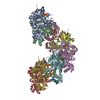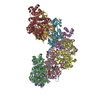+ Open data
Open data
- Basic information
Basic information
| Entry | Database: PDB / ID: 8rcf | ||||||||||||||||||||||||||||||||||||
|---|---|---|---|---|---|---|---|---|---|---|---|---|---|---|---|---|---|---|---|---|---|---|---|---|---|---|---|---|---|---|---|---|---|---|---|---|---|
| Title | RAD51 nucleoprotein filament on double-stranded abasic DNA | ||||||||||||||||||||||||||||||||||||
 Components Components |
| ||||||||||||||||||||||||||||||||||||
 Keywords Keywords | DNA BINDING PROTEIN / Homologous recombination / DNA replication / abasic DNA | ||||||||||||||||||||||||||||||||||||
| Function / homology |  Function and homology information Function and homology informationpresynaptic intermediate filament cytoskeleton / response to glucoside / mitotic recombination-dependent replication fork processing / DNA recombinase assembly / cellular response to camptothecin / chromosome organization involved in meiotic cell cycle / telomere maintenance via telomere lengthening / double-strand break repair involved in meiotic recombination / nuclear ubiquitin ligase complex / cellular response to cisplatin ...presynaptic intermediate filament cytoskeleton / response to glucoside / mitotic recombination-dependent replication fork processing / DNA recombinase assembly / cellular response to camptothecin / chromosome organization involved in meiotic cell cycle / telomere maintenance via telomere lengthening / double-strand break repair involved in meiotic recombination / nuclear ubiquitin ligase complex / cellular response to cisplatin / DNA strand invasion / cellular response to hydroxyurea / mitotic recombination / DNA strand exchange activity / replication-born double-strand break repair via sister chromatid exchange / lateral element / regulation of DNA damage checkpoint / Impaired BRCA2 binding to PALB2 / telomere maintenance via recombination / single-stranded DNA helicase activity / reciprocal meiotic recombination / Homologous DNA Pairing and Strand Exchange / Defective homologous recombination repair (HRR) due to BRCA1 loss of function / Defective HDR through Homologous Recombination Repair (HRR) due to PALB2 loss of BRCA1 binding function / Defective HDR through Homologous Recombination Repair (HRR) due to PALB2 loss of BRCA2/RAD51/RAD51C binding function / Resolution of D-loop Structures through Synthesis-Dependent Strand Annealing (SDSA) / Resolution of D-loop Structures through Holliday Junction Intermediates / HDR through Single Strand Annealing (SSA) / regulation of double-strand break repair via homologous recombination / ATP-dependent DNA damage sensor activity / nuclear chromosome / Impaired BRCA2 binding to RAD51 / Transcriptional Regulation by E2F6 / replication fork processing / Presynaptic phase of homologous DNA pairing and strand exchange / response to X-ray / ATP-dependent activity, acting on DNA / interstrand cross-link repair / condensed chromosome / DNA polymerase binding / condensed nuclear chromosome / cellular response to ionizing radiation / meiotic cell cycle / male germ cell nucleus / cellular response to gamma radiation / double-strand break repair via homologous recombination / PML body / HDR through Homologous Recombination (HRR) / response to toxic substance / Meiotic recombination / single-stranded DNA binding / site of double-strand break / double-stranded DNA binding / DNA recombination / chromosome, telomeric region / mitochondrial matrix / response to xenobiotic stimulus / DNA repair / DNA damage response / centrosome / chromatin binding / chromatin / nucleolus / perinuclear region of cytoplasm / enzyme binding / protein-containing complex / ATP hydrolysis activity / mitochondrion / nucleoplasm / ATP binding / identical protein binding / nucleus / cytoplasm / cytosol Similarity search - Function | ||||||||||||||||||||||||||||||||||||
| Biological species |  Homo sapiens (human) Homo sapiens (human) | ||||||||||||||||||||||||||||||||||||
| Method | ELECTRON MICROSCOPY / helical reconstruction / cryo EM / Resolution: 3.4 Å | ||||||||||||||||||||||||||||||||||||
 Authors Authors | Appleby, R. / Pellegrini, L. | ||||||||||||||||||||||||||||||||||||
| Funding support |  United Kingdom, 1items United Kingdom, 1items
| ||||||||||||||||||||||||||||||||||||
 Citation Citation |  Journal: Mol Cell / Year: 2024 Journal: Mol Cell / Year: 2024Title: RAD51 protects abasic sites to prevent replication fork breakage. Authors: Yodhara Wijesekara Hanthi / Miguel Angel Ramirez-Otero / Robert Appleby / Anna De Antoni / Luay Joudeh / Vincenzo Sannino / Salli Waked / Alessandra Ardizzoia / Viviana Barra / Daniele ...Authors: Yodhara Wijesekara Hanthi / Miguel Angel Ramirez-Otero / Robert Appleby / Anna De Antoni / Luay Joudeh / Vincenzo Sannino / Salli Waked / Alessandra Ardizzoia / Viviana Barra / Daniele Fachinetti / Luca Pellegrini / Vincenzo Costanzo /    Abstract: Abasic sites are DNA lesions repaired by base excision repair. Cleavage of unrepaired abasic sites in single-stranded DNA (ssDNA) can lead to chromosomal breakage during DNA replication. How rupture ...Abasic sites are DNA lesions repaired by base excision repair. Cleavage of unrepaired abasic sites in single-stranded DNA (ssDNA) can lead to chromosomal breakage during DNA replication. How rupture of abasic DNA is prevented remains poorly understood. Here, using cryoelectron microscopy (cryo-EM), Xenopus laevis egg extracts, and human cells, we show that RAD51 nucleofilaments specifically recognize and protect abasic sites, which increase RAD51 association rate to DNA. In the absence of BRCA2 or RAD51, abasic sites accumulate as a result of DNA base methylation, oxidation, and deamination, inducing abasic ssDNA gaps that make replicating DNA fibers sensitive to APE1. RAD51 assembled on abasic DNA prevents abasic site cleavage by the MRE11-RAD50 complex, suppressing replication fork breakage triggered by an excess of abasic sites or POLθ polymerase inhibition. Our study highlights the critical role of BRCA2 and RAD51 in safeguarding against unrepaired abasic sites in DNA templates stemming from base alterations, ensuring genomic stability. | ||||||||||||||||||||||||||||||||||||
| History |
|
- Structure visualization
Structure visualization
| Structure viewer | Molecule:  Molmil Molmil Jmol/JSmol Jmol/JSmol |
|---|
- Downloads & links
Downloads & links
- Download
Download
| PDBx/mmCIF format |  8rcf.cif.gz 8rcf.cif.gz | 446.5 KB | Display |  PDBx/mmCIF format PDBx/mmCIF format |
|---|---|---|---|---|
| PDB format |  pdb8rcf.ent.gz pdb8rcf.ent.gz | 368.2 KB | Display |  PDB format PDB format |
| PDBx/mmJSON format |  8rcf.json.gz 8rcf.json.gz | Tree view |  PDBx/mmJSON format PDBx/mmJSON format | |
| Others |  Other downloads Other downloads |
-Validation report
| Summary document |  8rcf_validation.pdf.gz 8rcf_validation.pdf.gz | 1.7 MB | Display |  wwPDB validaton report wwPDB validaton report |
|---|---|---|---|---|
| Full document |  8rcf_full_validation.pdf.gz 8rcf_full_validation.pdf.gz | 1.7 MB | Display | |
| Data in XML |  8rcf_validation.xml.gz 8rcf_validation.xml.gz | 74 KB | Display | |
| Data in CIF |  8rcf_validation.cif.gz 8rcf_validation.cif.gz | 103.9 KB | Display | |
| Arichive directory |  https://data.pdbj.org/pub/pdb/validation_reports/rc/8rcf https://data.pdbj.org/pub/pdb/validation_reports/rc/8rcf ftp://data.pdbj.org/pub/pdb/validation_reports/rc/8rcf ftp://data.pdbj.org/pub/pdb/validation_reports/rc/8rcf | HTTPS FTP |
-Related structure data
| Related structure data |  19051MC  8rcdC C: citing same article ( M: map data used to model this data |
|---|---|
| Similar structure data | Similarity search - Function & homology  F&H Search F&H Search |
- Links
Links
- Assembly
Assembly
| Deposited unit | 
|
|---|---|
| 1 |
|
- Components
Components
| #1: Protein | Mass: 37009.125 Da / Num. of mol.: 8 Source method: isolated from a genetically manipulated source Source: (gene. exp.)  Homo sapiens (human) / Gene: RAD51, RAD51A, RECA / Production host: Homo sapiens (human) / Gene: RAD51, RAD51A, RECA / Production host:  #2: DNA chain | | Mass: 6282.902 Da / Num. of mol.: 1 / Source method: obtained synthetically Details: 3DR refers to an abasic nucleotide. The ribose of the abasic nucleotide is a tetrahydrofurane lacking the hydroxyl group that would naturally be present on position C1 after base hydrolysis. ...Details: 3DR refers to an abasic nucleotide. The ribose of the abasic nucleotide is a tetrahydrofurane lacking the hydroxyl group that would naturally be present on position C1 after base hydrolysis. The sequence consists of 7 x TG(3DR) + TG, as helically averaged version of the DNA sequence: GGTAT(3DR)CA(3DR)TG(3DR)TA(3DR)AC(3DR)TGAGC, which contains 5 central, equally spaced abasic sites flanked by 5 nucleotides. Source: (synth.)  Homo sapiens (human) Homo sapiens (human)#3: DNA chain | | Mass: 6798.423 Da / Num. of mol.: 1 / Source method: obtained synthetically Details: The sequence consists of 7 x CAC + CA, as helically averaged version of the DNA sequence: GCTCACGTCTACCACTGCATACC Source: (synth.)  Homo sapiens (human) Homo sapiens (human)#4: Chemical | ChemComp-CA / #5: Chemical | ChemComp-ATP / Has ligand of interest | Y | Has protein modification | N | |
|---|
-Experimental details
-Experiment
| Experiment | Method: ELECTRON MICROSCOPY |
|---|---|
| EM experiment | Aggregation state: FILAMENT / 3D reconstruction method: helical reconstruction |
- Sample preparation
Sample preparation
| Component |
| ||||||||||||||||||||||||
|---|---|---|---|---|---|---|---|---|---|---|---|---|---|---|---|---|---|---|---|---|---|---|---|---|---|
| Molecular weight | Experimental value: NO | ||||||||||||||||||||||||
| Source (natural) |
| ||||||||||||||||||||||||
| Source (recombinant) |
| ||||||||||||||||||||||||
| Buffer solution | pH: 7.5 | ||||||||||||||||||||||||
| Specimen | Embedding applied: NO / Shadowing applied: NO / Staining applied: NO / Vitrification applied: YES | ||||||||||||||||||||||||
| Specimen support | Grid material: GOLD / Grid mesh size: 300 divisions/in. / Grid type: UltrAuFoil R1.2/1.3 | ||||||||||||||||||||||||
| Vitrification | Instrument: FEI VITROBOT MARK IV / Cryogen name: ETHANE |
- Electron microscopy imaging
Electron microscopy imaging
| Experimental equipment |  Model: Titan Krios / Image courtesy: FEI Company |
|---|---|
| Microscopy | Model: FEI TITAN KRIOS |
| Electron gun | Electron source:  FIELD EMISSION GUN / Accelerating voltage: 300 kV / Illumination mode: FLOOD BEAM FIELD EMISSION GUN / Accelerating voltage: 300 kV / Illumination mode: FLOOD BEAM |
| Electron lens | Mode: BRIGHT FIELD / Calibrated magnification: 130000 X / Nominal defocus max: 2600 nm / Nominal defocus min: 800 nm |
| Specimen holder | Cryogen: NITROGEN / Specimen holder model: FEI TITAN KRIOS AUTOGRID HOLDER |
| Image recording | Average exposure time: 1.2 sec. / Electron dose: 52.968 e/Å2 / Film or detector model: GATAN K3 (6k x 4k) / Num. of real images: 10084 Details: Images were collected in movie mode at 44 frames per movie |
- Processing
Processing
| EM software |
| ||||||||||||||||||||||||||||
|---|---|---|---|---|---|---|---|---|---|---|---|---|---|---|---|---|---|---|---|---|---|---|---|---|---|---|---|---|---|
| CTF correction | Type: PHASE FLIPPING AND AMPLITUDE CORRECTION | ||||||||||||||||||||||||||||
| Helical symmerty | Angular rotation/subunit: 56 ° / Axial rise/subunit: 15.8 Å / Axial symmetry: C1 | ||||||||||||||||||||||||||||
| Particle selection | Num. of particles selected: 1791680 | ||||||||||||||||||||||||||||
| 3D reconstruction | Resolution: 3.4 Å / Resolution method: FSC 0.143 CUT-OFF / Num. of particles: 8853 / Symmetry type: HELICAL | ||||||||||||||||||||||||||||
| Atomic model building | Protocol: OTHER / Space: REAL | ||||||||||||||||||||||||||||
| Atomic model building | PDB-ID: 8BR2 Accession code: 8BR2 / Source name: PDB / Type: experimental model | ||||||||||||||||||||||||||||
| Refine LS restraints |
|
 Movie
Movie Controller
Controller




 PDBj
PDBj















































